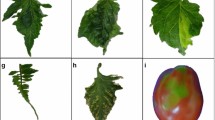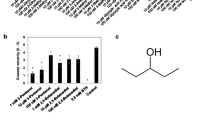Abstract
Beet curly top disease is one of the most important viral diseases that causes economic damage to the yield of beet crops. The present study aimed to evaluate the effect of treating the Paya cultivar of sugar beet with Bacillus subtilis, Trichoderma harzianum, and Beta-aminobutyric acid (BABA), alone and in combination, on the growth and reaction of sugar beet to Beet curly top virus-Svr (BCTV-Svr). Anthocyanin concentration, peroxidase, and polyphenol oxidase enzyme activity were measured by spectrophotometry 14 days post-inoculation (dpi). At thirty dpi, virus accumulation was measured by quantitative polymerase chain reaction (qPCR), and physiological parameters in plants were assessed. The experiments were performed in a factorial, completely randomized design. The first symptoms of BCTV-Svr were observed at nine dpi in the control plants, while the symptoms appeared at 19 dpi in plants treated with B. subtilis, and between 12 and 14 dpi in the other treatments. Plants treated with B. subtilis and BABA showed the lowest and highest severity of the disease, respectively. The results of qPCR were consistent with the symptom severity results, and showed a significant difference in BCTV-Svr accumulation among the treatments. The highest level of anthocyanin concentration was observed in the B. subtilis treatment. On the other hand, polyphenol oxidase and peroxidase activity was increased using viral stress treatments at 14 dpi. The analyses showed that, in general, B. subtilis was more effective in inducing anthocyanin and enzyme activity in healthy and infected plants than the other treatments.





Similar content being viewed by others
Data Availability
Data is available if requested.
References
Almoneafy, A. A., Ojaghian, M. R., Seng-fu, X., Ibrahim, M., Guan-Lin, X., Yu, S., Wen-Xiao, T., & Bin, L. (2013). Synergistic effect of acetyl salicylic acid and DL-Beta-aminobutyric acid on biocontrol efficacy of bacillus strains against tomato bacterial wilt. Tropical Plant Pathology., 38, 102–113. https://doi.org/10.1590/S1982-56762013000200003
Beris, D., Theologidis, I., Skandalis, N., & Vassilakos, N. (2018). Bacillus amyloliquefaciens strain MBI600 induces salicylic acid-dependent resistance in tomato plants against tomato spotted wilt virus and potato virus Y. Scientific Reports, 8. https://doi.org/10.1038/s41598-018-28677-3
Brown, J. K., & Hernandez-Zepeda, C. (2011). Characterization of two newly described Curtovirus isolated from spinach in south-central Arizona. Phytopathology, 101, 3340.
Chen, L. F., Brannigan, K., Clark, R., & Gilbertson, R. L. (2010). Characterization of Curtoviruses associated with curly top disease of tomato in California and monitoring for these viruses in beet leafhoppers. Plant Disease, 94, 99–108. https://doi.org/10.1094/pdis-94-1-0099
Conrath, U. (2011). Molecular aspects of defence priming. Trends in Plant Science, 16, 524–531. https://doi.org/10.1016/j.tplants.2011.06.004
Cook, W. C. (1967). Life history, host plants, and migrations of the beet leafhopper in the Western United States. Agricultural Research Service, US Department of Agriculture.
Doyle, J. J., & Doyle, J. L. (1987). A rapid DNA isolation procedure for small quantities of fresh leaf tissue. Phytochemistry, Bull. 19, 11–15.
Duffus, J. E., & Skoyen, I. O. (1977). Relationship of age of plants and resistance to a severe isolate of the beet curly top virus. Phytopathology, 77, 151–151. https://doi.org/10.1094/phyto-67-151
Ebadzad, S. G., Bahjatina, S. A. A. & Izadpanah, K. (2008). Infectivity of the cloned genome of Iranian isolate of beet severe curly top virus in experimental host. Iranian Journal of Plant Pathology, 44, 176–183
Egbuna, C., Ifemeje, J. C., Maryann C. M., Habibu T., Udedi, S. C., Nwaka, A. C., & Maryjane O. I. (2018). Phytochemical test methods: qualitative, quantitative, and proximate analysis. Phytochemistry, 381–426. https://doi.org/10.1201/9780429426223-15
Faria, J. C., Abino, M. M., Dias, B. B., Cançado, L. J., da Cunha, N. B., Silva, L. D. M., Vianna, G. R. & Aragao, F. (2006). Partial resistance to bean golden mosaic virus in a transgenic common bean (Phaseolus vulgaris L.) line expressing a mutated Rep gene. Plant Science, 171(5), 565–571. https://doi.org/10.1016/.plansci.2006.06.010
Grimsley, N., Hohn, B., Hohn, T., & Walden, R. (1986). Agroinfection, an alternative route for viral infection of plants by using the Ti plasmid. Proceedings of the National Academy of Sciences of the USA, 83, 3282–3286. https://doi.org/10.1073/pnas.83.10.3282
Harish, S., Kavino, M., Kumar, N., Saravanakumar, D., Soorianathasundaram, K., & Samiyappan, R. (2008). Biohardening with plant growth-promoting rhizosphere and endophytic bacteria induces systemic resistance against banana bunchy top virus. Applied Soil Ecology, 39, 187–200. https://doi.org/10.1016/j.apsoil.2007.12.006
Hull, R. (1989). The Movement of viruses in plants. Annual Review of Phytopathology, 27, 213–240. https://doi.org/10.1146/annurev.py.27.090189.001241
Jahanbin, D., Behjatnia, S. A. A., Izadpanah, K., & Moghadam, A. (2017). Interaction of viruses causing beet curly top disease with tomato yellow leaf curl virus in tomato plants under greenhouse conditions. Iranian Journal of Plant Pathology, 53, 417–430.
Jetiyanon, K. (2007). Defensive-related enzyme response in plants treated with a mixture of Bacillus strains (IN937a and IN937b) against different pathogens. Biological Control, 2, 178–185. https://doi.org/10.1016/j.biocontrol.2007.05.008
Kessmann, H., Staub, T., Ligon, J., Oostendorp, M., & Ryals, J. (1994). Activation of systemic acquired disease resistance in plants. European Journal of Plant Pathology, 100, 359–369. https://doi.org/10.1007/bf01874804
Kumar, K., Pal, G., Verma, A., Kumar, D., Shukla, P., & Verma, S. K. (2023). Seed-vectored bacterial endophyte Bacillus pumilus protects sorghum (Sorghum bicolor L.) seedlings from a fungal pathogen Rhizoctonia solani. Biological Control, 183, 105249. https://doi.org/10.1016/j.biocontrol.2023.105249
Kuvalekar, A., Redkar, A., Gandhe, K., & Harsulkar, A. (2011). Peroxidase and polyphenol oxidase activities in compatible host–pathogen interaction in Jasminum officinale and Uromyces hobsoni: Insights into the susceptibility of the host. New Zealand Journal of Botany., 49, 351–359. https://doi.org/10.1080/0028825x.2011.569727
Luo, Y., Zhang, D.-D., Dong, X.-W., Zhao, P.-B., Chen, L.-L., Song, X.-Y., Wang, X.-J., Chen, X.-L., Shi, M., & Zhang, Y.-Z. (2010). Antimicrobial peptaibols induce defense responses and systemic resistance in tobacco against tobacco mosaic virus. FEMS Microbiology Letters, 313, 120–126. https://doi.org/10.1111/j.1574-6968.2010.02135.x
Mafakheri, A., Siosemardeh, A. F., Bahramnejad, B., Struik, P. C., & Sohrabi, Y. (2010). Effect of drought stress on yield, proline, and chlorophyll contents in three chickpea cultivars. Australian Journal of Crop Science, 4, 580–585.
Mastouri, F., Björkman, T., & Harman, G. E. (2010). Seed treatment with Trichoderma harzianum alleviates biotic, abiotic, and physiological stresses in germinating seeds and seedlings. Phytopathology, 11, 1213–1221. https://doi.org/10.1094/PHYTO-03-10-0091
Montazeri, R., Shams-Bakhsh, M., Mahmoudi, S. B., & Rajabi, A. (2016). Evaluation of sugar beet lines for resistance to beet curly top viruses. Euphytica, 210, 31–40. https://doi.org/10.1007/s10681-016-1693-3
Park, J. W., Balaraju, K., Kim, J.-W., Lee, S.-W., & Park, K. (2013). Systemic resistance and growth promotion of chili pepper induced by an antibiotic producing Bacillus vallismortis strain BS07. Biological Control, 65, 246–257. https://doi.org/10.1016/j.biocontrol.2013.02.002
Pieterse, C. M. J., van Wees, S. C. M., van Pelt, J. A., Knoester, M., Laan, R., Gerrits, H., Weisbeek, P. J., & van Loon, L. C. (1998). A novel signaling pathway controlling induced systemic resistance in Arabidopsis. The Plant Cell, 10, 1571. https://doi.org/10.2307/3870620
Raupach, G. S. (1996). Induced systemic resistance in cucumber and tomato against cucumber mosaic Cucumovirus using plant growth-promoting rhizobacteria (PGPR). Plant Disease, 80, 891. https://doi.org/10.1094/pd-80-0891
Ryals, J. A., Neuenschwander, U. H., Michael G, W., Molina, A., Steiner, H.-Y., & Hunt, M. D. (1996). Systemic acquired resistance. Plant Cell, 1809. https://doi.org/10.1105/tpc.8.10.1809.
Siegrist, J., Orober, M., & Buchenauer, H. (2000). β-Aminobutyric acid-mediated enhancement of resistance in tobacco-to-tobacco mosaic virus depends on the accumulation of salicylic acid. Physiological and Molecular Plant Pathology, 56, 95–106. https://doi.org/10.1006/pmpp.1999.0255
Soto, M. J., & Gilbertson, R. L. (2003). Distribution and rate of movement of the Curtovirus beet mild curly top virus (Family Geminiviridae) in the Beet Leafhopper. Phytopathology, 93, 478–484. https://doi.org/10.1094/phyto.2003.93.4.478
Soto, M. J., Chen, L.-F., Seo, Y. S., & Gilbertson, R. L. (2005). Identification of regions of the beet mild curly top virus (family Geminiviridae) capsid protein involved in systemic infection, virion formation and leafhopper transmission. Virology, 341, 257–270. https://doi.org/10.1016/j.virol.2005.07.009
van Loon, L. C., Bakker, P. A. H. M., & Pieterse, C. M. J. (1998). Systemic resistance induced by rhizosphere bacteria. Annual Review of Phytopathology, 36, 453–483. https://doi.org/10.1146/annurev.phyto.36.1.453
Weinstein, J. N., Myers, T. G., O’Connor, P. M., Friend, S. H., Fornace, A. J., Kohn, K. W., Fojo, T., Bates, S. E., Rubinstein, L. V., Anderson, N. L., Buolamwini, J. K., van Osdol, W. W., Monks, A. P., Scudiero, D. A., Sausville, E. A., Zaharevitz, D. W., Bunow, B., Viswanadhan, V. N., Johnson, G. S., … Paull, K. D. (1997). An information-intensive approach to the molecular pharmacology of cancer. Science, 275, 343–349. https://doi.org/10.1126/science.275.5298.343
Acknowledgements
This research was financially supported by Tarbiat Modares University, Tehran, Iran.
Funding
This work was funded by Tarbiat Modares University.
Author information
Authors and Affiliations
Contributions
K. Mafakheri carried out all experiments and drafted the manuscript, S. Astaraki helped in the manuscript writing, N. Safaie helped supervise the project, and M. Shams-bakhsh supervised the project and edited the manuscript.
Corresponding author
Ethics declarations
Conflict of interest
The authors declare that the research was conducted in the absence of any commercial or financial relationships that could be construed as a potential conflict of interest.
Supplementary Information
Below is the link to the electronic supplementary material.
10658_2024_2843_MOESM1_ESM.pptx
Supplementary file1 (PPTX 57 KB) Fig S1. Interaction plot for polyphenol oxidase (PPO) in single and combined treatments. 1 and 2 indicate non-use and use of the treatment, respectively. Fig S2. Interaction plot for peroxidase (POD) in single and combined treatments. 1 and 2 indicate non-use and use of the treatment, respectively.
Rights and permissions
Springer Nature or its licensor (e.g. a society or other partner) holds exclusive rights to this article under a publishing agreement with the author(s) or other rightsholder(s); author self-archiving of the accepted manuscript version of this article is solely governed by the terms of such publishing agreement and applicable law.
About this article
Cite this article
Mafakheri, K., Astaraki, S., Safaie, N. et al. Seed bio-/chemo-priming affects the reaction of sugar beet plants to Beet curly top virus-Svr. Eur J Plant Pathol (2024). https://doi.org/10.1007/s10658-024-02843-y
Accepted:
Published:
DOI: https://doi.org/10.1007/s10658-024-02843-y




